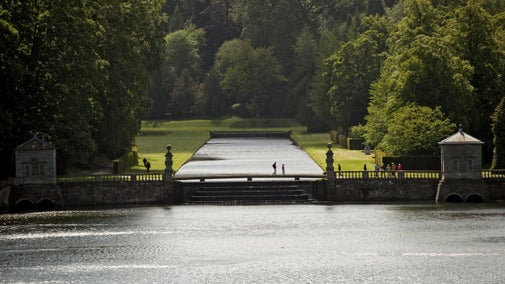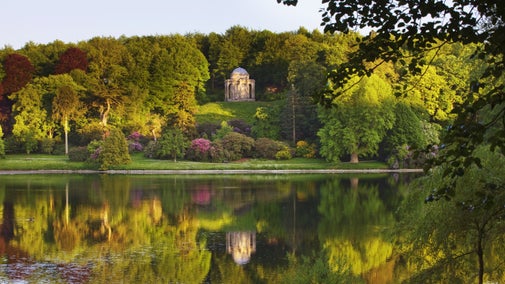History of Fountains Abbey and Studley Royal

The ruins at Fountains Abbey are the largest monastic ruins in the country. Step back into a rich and dramatic past and imagine what life would have been like for the monks who first came here years ago, and learn how Fountains Abbey and Studley Royal became one.
Fountains Abbey
The abbey’s beginnings
The abbey was founded in 1132 by 13 Benedictine monks from St Mary’s in York. They'd grown tired of the extravagant and rowdy way that the monks lived in York and so they escaped, seeking to live a devout and simple lifestyle elsewhere. This was how they came to Fountains.
By the time three years had passed the monks had become settled into their new way of life and had been admitted to the austere Cistercian Order. With that came an important development – the introduction of the Cistercian system of lay brothers.
Introduction of the lay brothers
The lay brothers (what we would now call labourers) relieved the monks from routine jobs, giving them more time to dedicate to God rather than farming the land to get by. It was because of the help of the lay brothers that Fountains became wealthy through wool production, lead mining, cattle rearing, horse breeding and stone quarrying.
Not all plain sailing at the abbey
Bad harvests hit the monks hard and combined with raids from the Scots throughout the 14th century, they experienced economic collapse. This was worsened by the Black Death which struck the country in 1348.
Despite its financial problems, the abbey remained important. The abbacy of Marmaduke Huby (1495–1526) marked a period of revival, and the great tower built by Huby symbolised his hope for the abbey’s future.
The Dissolution
The abbey was abruptly closed in 1539 during the Dissolution of the Monasteries ordered by Henry VIII. The abbot, prior and monks were sent away with pensions.
Fountains Abbey today
The estate was sold by the Crown to a merchant, Sir Richard Gresham. It remained in private hands until the 1960s. The National Trust bought the estate from the West Riding County Council in 1983.
Idleness is the enemy of the soul. For this reason the brethren should be occupied at certain times in manual labour and at other times in sacred reading.

Studley Royal
Studley Royal Water Garden is the result of the vision of John Aislabie and his son William. Recognised as a site of cultural importance, it was granted World Heritage Site status in 1986.
The beginnings of Studley Royal
In the early 18th century John Aislabie had great plans to impress visitors to his Yorkshire estate and turned the wild and wooded valley of the River Skell into one of England’s most spectacular Georgian water gardens.
John Aislabie inherited the Studley Royal estate in 1693. He was a socially and politically ambitious man and became Chancellor of the Exchequer in 1718.
Disaster struck his career in 1720 due to his part in the South Sea Bubble financial scandal and he was expelled from Parliament. It was then that John returned to Yorkshire and devoted himself to creating this groundbreaking garden.
Inspired by the work of the great French landscape gardeners, the two gifted amateurs created the Water Garden with its formal, geometric design and extraordinary vistas, including the Temple of Piety.
Two estates become one
The purchase of the abbey
In 1767 William Aislabie bought the Fountains Abbey ruins to complete the garden and create the ultimate vista. The climax of the garden is known as the ‘Surprise View’ or ‘Anne Boleyn’s Seat.’
‘Surprise View’ refers to the astonishing view of the abbey ruins in the distance and was designed to cause a sharp intake of breath when visitors to the garden came across it.
The garden you see today is little changed from the one that would have impressed Aislabie’s visitors 200 years ago.

You might also be interested in

Things to do at Fountains Abbey
The ruins of Fountains Abbey are truly something to behold. Discover what to see when you come face to face with some of the oldest abbey ruins in the country.

Things to do at Studley Royal
The evocative ruins of the abbey are set beside the grounds of Studley Royal, a medieval deer park in Yorkshire. It was declared Yorkshire’s first World Heritage Site in 1986.

World Heritage Site Fountains Abbey and Studley Royal
Find out how Fountains Abbey and Studley Royal became a UNESCO World Heritage Site in 1986 and how we're preserving its unique features for future generations to enjoy.

What is a water garden?
Find out how water gardens have evolved with changing tastes, from European inspiration and ornamental canals to the water feature in your garden today.

History
Learn about people from the past, discover remarkable works of art and brush up on your knowledge of architecture and gardens.